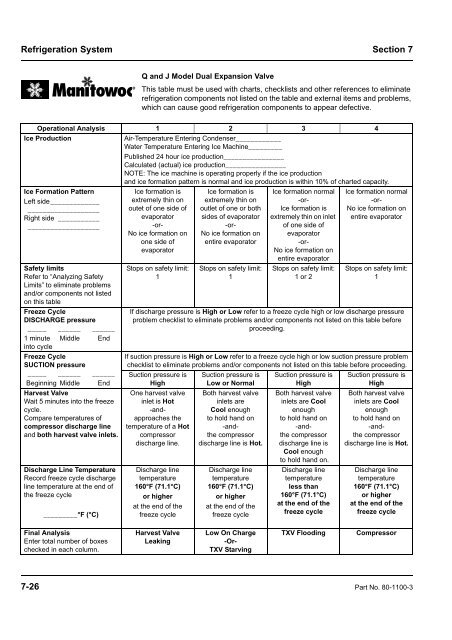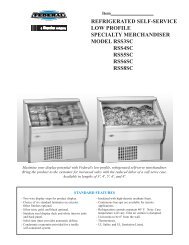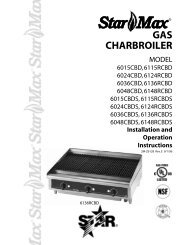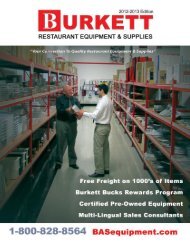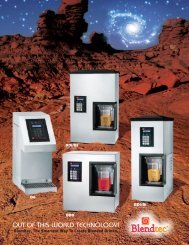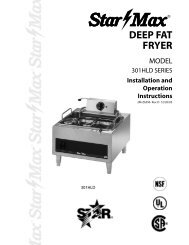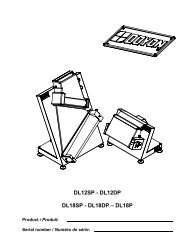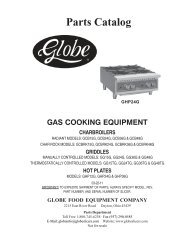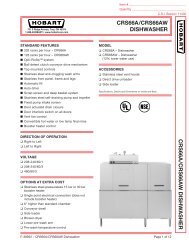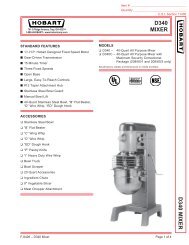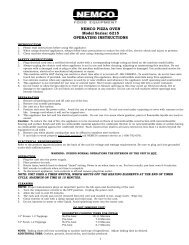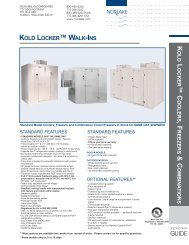ICE MACHINES Q-Model Service Manual
ICE MACHINES Q-Model Service Manual
ICE MACHINES Q-Model Service Manual
- No tags were found...
You also want an ePaper? Increase the reach of your titles
YUMPU automatically turns print PDFs into web optimized ePapers that Google loves.
Refrigeration System Section 7Q and J <strong>Model</strong> Dual Expansion ValveThis table must be used with charts, checklists and other references to eliminaterefrigeration components not listed on the table and external items and problems,which can cause good refrigeration components to appear defective.Operational Analysis 1 2 3 4Ice ProductionAir-Temperature Entering Condenser____________Water Temperature Entering Ice Machine_________Published 24 hour ice production________________Calculated (actual) ice production________________NOTE: The ice machine is operating properly if the ice productionand ice formation pattern is normal and ice production is within 10% of charted capacity.Ice Formation PatternLeft side________________________________Right side ______________________________Safety limitsRefer to “Analyzing SafetyLimits” to eliminate problemsand/or components not listedon this tableFreeze CycleDISCHARGE pressure_____ ______ ______1 minute Middle Endinto cycleFreeze CycleSUCTION pressure_____ ______ ______Beginning Middle EndHarvest ValveWait 5 minutes into the freezecycle.Compare temperatures ofcompressor discharge lineand both harvest valve inlets.Discharge Line TemperatureRecord freeze cycle dischargeline temperature at the end ofthe freeze cycle_________°F (°C)Ice formation isextremely thin onoutet of one side ofevaporator-or-No ice formation onone side ofevaporatorStops on safety limit:1Ice formation isextremely thin onoutlet of one or bothsides of evaporator-or-No ice formation onentire evaporatorStops on safety limit:1Ice formation normal-or-Ice formation isextremely thin on inletof one side ofevaporator-or-No ice formation onentire evaporatorStops on safety limit:1 or 2Ice formation normal-or-No ice formation onentire evaporatorStops on safety limit:1If discharge pressure is High or Low refer to a freeze cycle high or low discharge pressureproblem checklist to eliminate problems and/or components not listed on this table beforeproceeding.If suction pressure is High or Low refer to a freeze cycle high or low suction pressure problemchecklist to eliminate problems and/or components not listed on this table before proceeding.Suction pressure isHighOne harvest valveinlet is Hot-andapproachesthetemperature of a Hotcompressordischarge line.Discharge linetemperature160°F (71.1°C)or higherat the end of thefreeze cycleSuction pressure isLow or NormalBoth harvest valveinlets areCool enoughto hold hand on-andthecompressordischarge line is Hot.Discharge linetemperature160°F (71.1°C)or higherat the end of thefreeze cycleSuction pressure isHighBoth harvest valveinlets are Coolenoughto hold hand on-andthecompressordischarge line isCool enoughto hold hand on.Discharge linetemperatureless than160°F (71.1°C)at the end of thefreeze cycleSuction pressure isHighBoth harvest valveinlets are Coolenoughto hold hand on-andthecompressordischarge line is Hot.Discharge linetemperature160°F (71.1°C)or higherat the end of thefreeze cycleFinal AnalysisEnter total number of boxeschecked in each column.Harvest ValveLeakingLow On Charge-Or-TXV StarvingTXV FloodingCompressor7-26 Part No. 80-1100-3


